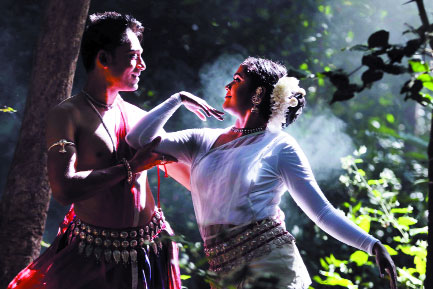Noted Odissi dancer and choreographer Sharmila Mukerjee says her adaptation of the Russian ballet, Swan Lake, is a vivid communication with her audience.
When Tchaikovsky’s Swan Lake premiered at the Bolshoi theatre, Moscow, in 1875, there was thrill and a moment of absolute happiness. “But only a moment,” or so wrote Tchaikovsky in his diary.
With numerous adaptations of the iconic ballet, there have also been a number of versions of the same story — where the dancers’ breathless skill is piqued by exquisite pain — however, no other version of the ballet had ever carried a cultural change in Swan Lake.
Odissi dancer and founder of Sanjali, Sharmila Mukerjee’s adaptation brings a complete cultural transformation presenting Hansika, the first Odissi adaptation of the Russian ballet. It showcases a western classical theme through an Indian classical one.
It is a compelling tale of romance and deception, an intimate portrait of a love affair between Prince Siegfried and Odette, a princess turned into a swan by an evil sorceress.
Through fluid Odissi movements, Mukerjee presents the classic through poses that make the artists look like sculptures and intricate footwork to lend itself into the fabric of ballet. She named it Hansika to “Indianise” the Russian folktale.
However, how challenging is it to transform a ballet story into a classical dance performance without any dialogues or narration?
Sharmila says that even though very explicit expressions are given to each sequence to make the feelings obvious and reachable to the audience, she has also used dialogues at three places in the whole act “otherwise it would have been impossible to tell the audience certain things. You can’t just enact a scene where the feelings do not have a large say. If the scene has a setup you have to bring in dialogues even in a dance performance.”
She adds that the major challenge was that she “had to edit the script in a way that the Indian audience could relate to it as well. I didn’t want to show just a story.”
While various other versions simply follow the plot, where an evil sorceress transforms the protagonist into a swan, Mukerjee’s adaptation also questions, why the sorceress suddenly becomes evil and why she curses? Why only swan and not any other animal? What could be the other things that lead to the events?
The dancer, whose first dance lessons in her childhood were in ballet, says that she has been highly inspired by ballet dancer Anna Pavlova. And Swan Lake has been one of her favourite ballet creations.
“There was not enough courage, preparation, financial stability, funding or dancers that I could have done it before. But I have always wanted to recreate it. It was a long-held dream for me,” says Mukerjee.
It is after they had a got the approval from the Ministry of Culture that the performance could be planned and staged.
So how was the performance structured? As the original tale has many acts and scenes, there was an ensemble of 25 artists. She explains that classical dances have always been colourful and visually bright, unlike ballet that generally uses light colours and mostly whites. “There were costumes, formations and expressions to present all the twists and turns in the Russian folktale,” says she.
The dancer has taught dance and movement therapy to deaf children in Kolkata and Bengaluru. She tells us that teaching them dance was really difficult. “We had to plan strategies as they need a lot of time and energy to channelise. I worked with therapists and attended workshops to figure a plan to teach them. We had a mega production in Kolkata comprising of 50 students. It turned out to be good. The children were very good at using facial expressions. Indeed challenging, but worth it,” she says.
She believes that for an artist, the path is never smooth. “It’s always a struggle. Emotionally, physically and mentally, there are things that are always draining you. There’s a lot of work and challenges, especially on financial notes. There’s no time for an artist to sit back and relax. Even now that I just completed Hansika, I am back to thinking about my next performance and production. So it’s a never-ending process.”
Talking about how social media has been taking over young minds and increasing competition among talents, she says, “Social media can be very deceptive and not everyone is doing good work there. This way, competition has indeed increased but no matter how much a person is doing, they are putting everything on social media, every bit of their work. They become overnight sensations but only for a short span. It’s difficult to be noticed so easily for good work but it doesn’t need social media to find recognition.”
Writer: Chahak Mittal
Courtesy: The Pioneer








 OpinionExpress.In
OpinionExpress.In















Comments (0)